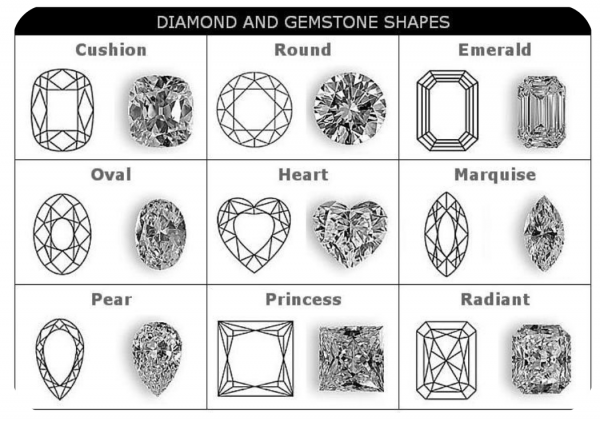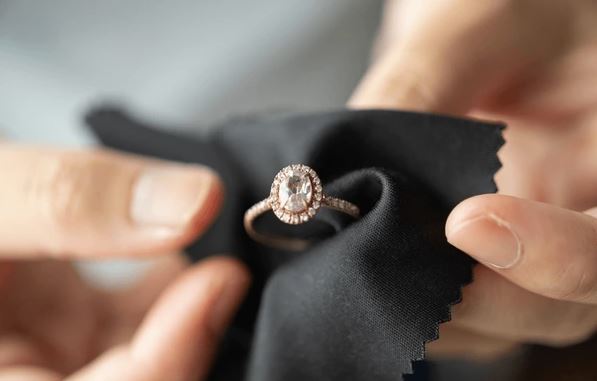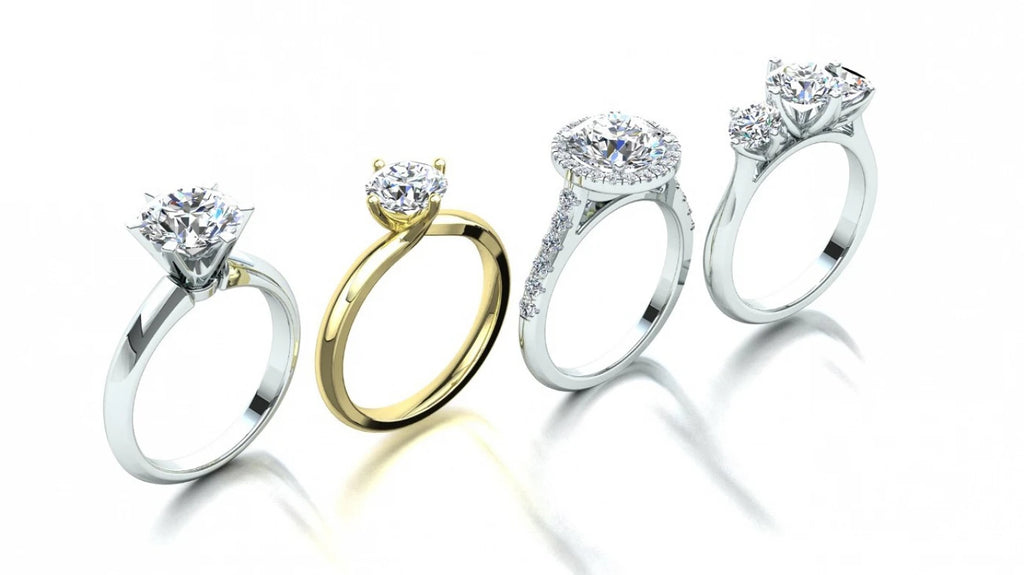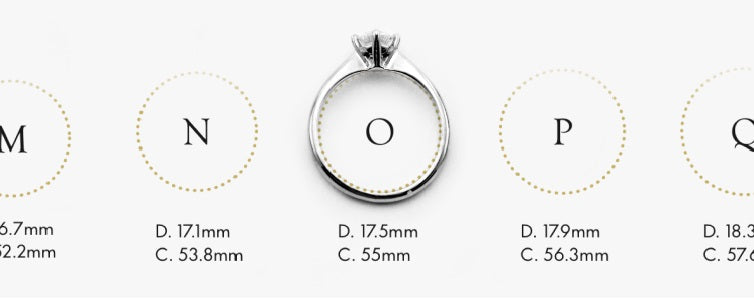
Diamond Shapes Chart & Buying Guide

In your search for the ideal diamond, you’ll eventually be faced with the choice of diamond shape for your stone. Different diamond shapes can dynamically change the appearance of any jewellery, and picking the right one can make all the difference in overall design and aesthetics. Our diamond shapes guide below will help you understand and choose from the various types of diamond shapes on the market.
Diamond Shapes Explained
As buyers' preferences evolve and market trends shift, the variety of diamond shapes available provides extensive customization options. The shape of a diamond plays a pivotal role in the selection process, significantly influencing the overall appearance of the jewelry piece it adorns.
For those seeking alternatives to the classic round diamond, an array of expressive options now exists. Shapes such as oval, emerald, princess, radiant, cushion, marquise, pear, asscher, and heart-shaped diamonds offer a diverse range of choices. Each shape possesses its unique characteristics, allowing buyers to tailor their selection to suit their individual style and preferences. Whether aiming for timeless elegance or contemporary flair, the variety of diamond shapes ensures there is something to cater to every taste and occasion.
Are Diamond Shapes and Cut the Same Thing?
While some diamond experts and retailers may use the terms "diamond shape" and "diamond cut" interchangeably, they actually carry distinct meanings.
Diamond shape refers to the unique outline or form of the stone, emphasizing its external appearance rather than the quality of its cut. On the other hand, the diamond cut refers specifically to the craftsmanship and precision with which the diamond facets are arranged and polished. This distinction is crucial in understanding the characteristics and value of a diamond.
In simpler terms, the diamond cut primarily influences the stone's brilliance and sparkle, as it directly impacts how light interacts with the diamond. Conversely, the diamond shape primarily affects the stone's overall aesthetic and silhouette, contributing to its visual appeal.
Therefore, when choosing a diamond, it's essential to consider both the shape and the quality of its cut as separate factors. While the shape determines the stone's outward appearance, the cut significantly influences its brilliance and overall beauty.
Diamond Shapes Chart

Different Shapes of Diamonds
Each diamond shape interacts with light in a unique manner, altering its brilliance and how it is perceived by the observer. Here are the various shapes that diamonds can exhibit:
Round-Shaped Diamonds
The traditional round-shaped diamond is the most recognisable and popular diamond shape in the world. It features a brilliant cut that contains 58 facets that are specially designed to deliver maximum shine and sparkle.
Oval-Shaped Diamonds
Oval diamonds are an alternative take on round diamonds that still feature a fully rounded edge but with a slight elongation on one axis. This diamond shape can be used to create a bigger, more impressive appearance.
Emerald-Shaped Diamonds
Having the most popular step-cut shape, emerald-shaped diamonds give off a subtle hint of elegance with an unconventional rectangular outline. The centre of the stone is cut to create the illusion of mirrors that highlight its clarity and offer reflective brilliance.
Princess-Shaped Diamonds
Renowned for their distinctive four-pointed corners, princess-cut diamonds offer a contemporary allure, coupled with a timeless brilliance. These square-shaped gems showcase more than 70 facets, resulting in remarkable fire and scintillation.
Radiant-Shaped Diamonds
A fusion of the sophisticated allure found in the emerald shape and the fiery brilliance of the round cut, the radiant-cut diamond stands as a stylish hybrid. Its chic and angular design, adorned with subtly trimmed corners, presents a distinct and contemporary charm.
Cushion-Shaped Diamonds
Distinguished by their gentle, rounded edges, cushion-cut diamonds set themselves apart from their sharper, square, or rectangular counterparts. This timeless and romantic selection has evolved over centuries, drawing inspiration from the classic old mine-cut.
Marquise-Shaped Diamonds
Characterised by striking pointed ends and a gracefully curved middle, marquise-shaped diamonds look like sharped ovals. This distinctive elongated shape flows well along the fingers, providing a flattering effect.
Pear-Shaped Diamonds
Displaying a teardrop shape with a rounded edge tapering to a point at the opposite end, pear-shaped diamonds offer a unique silhouette. Similar to an oval-cut, this elongated shape provides an accent to the fingers, highlighting the distinct sparkle of the stone.
Asscher-Shaped Diamonds
In a manner reminiscent of the emerald-cut, asscher-shaped diamonds showcase the dazzling brilliance characteristic of a step-cut gem. Possessing a square shape with trimmed corners, these diamonds are comfortable in both modern settings and vintage styles.
Heart-Shaped Diamonds
Symbolic of romance, heart-shaped diamonds gleam with two perfectly symmetrical halves. This meaningful crafted shape has precise symmetry, allowing the diamond's sparkle to take centre stage.
Ideal Length-To-Width (L:W) Ratio for Each Diamond Shape
The length-to-width ratio of a diamond determines how symmetrical it is. Some diamond shapes will naturally look better with more symmetry, while others depend on higher ratios to maintain their distinctive shape.- Round: The ideal ratio is 1 for round diamonds for perfectly symmetrical circles.
- Oval: The oval ratio ranges between 1.3 to 1.5. Stones with ratios closer to 1.3 are rounder while those closer to 1.5 are longer.
- Emerald: Emerald-shaped diamonds have a ratio ranging from 1.3 to 1.45 to create a rectangular outline.
-
Princess: Similar to round diamonds, the best range for princess diamonds is from 1 to 1.04 for a sturdy square appearance that draws attention to its gleaming corners.
- Cushion: The ratio of cushion diamonds is between princess and emerald cuts at 1.14 — slightly more rectangular than square.
- Marquise: Marquise diamonds have the highest ratios from 1.85 to 2.1 due to their thin and sleek frame.
- Radiant: Radiant diamond L:W ratios have a wide allowance of 1.35 or higher for greater customisability in shape.
- Pear: Similar to ovals, the ratio for pear diamonds is higher due to the longer and thicker bottom. Pear diamond ratios are acceptable between 1.4 and 1.7.
- Asscher: The square shape of asscher diamonds requires a ratio as close to 1 as possible to provide a clear frame to showcase the internal octagonal facets.
- Heart: Heart-shaped diamonds must have a ratio close to 1 for symmetry between their two halves.
What Diamond Shape Looks the Biggest?
When maintaining a consistent diamond carat size across all shapes, the appearance of larger diamonds is often achieved with elongated shapes like oval, marquise, and pear diamonds. However, it's important to note that these elongated shapes may sometimes exhibit a diamond bowtie effect—a dark, bowtie-shaped shadow visible across the center of the diamond when viewed face-up. This optical phenomenon occurs due to the interaction of light with the diamond's facets and is often a result of misalignment or uneven distribution of light.
Despite the allure of size, it's essential to consider the pros and cons of each diamond shape. While elongated shapes may create the illusion of a larger stone, they may also come with the presence of a diamond bowtie. Therefore, it's crucial to weigh these factors against personal preferences and style considerations.
Ultimately, the key is to choose a diamond shape that complements your (or your loved one's) individual style and preferences. A well-chosen diamond engagement ring or jewellery piece, thoughtfully designed and set, will exude elegance and sophistication, making a lasting impression that transcends mere size.
How Do Different Diamond Shapes Affect Price?
Round diamonds are widely regarded as the most esteemed diamond shape, commanding the highest prices solely based on their shape. In contrast, the prices of other diamond shapes, ranging from princess cuts to emeralds, can fluctuate significantly depending on prevailing fashion trends and the popularity of specific shapes.
Shapes like round diamonds and marquise diamonds, renowned for their timeless appeal, tend to maintain consistently high prices. This is attributed to their perceived value and their versatility to complement a wide range of settings, making them enduring favorites among buyers.




